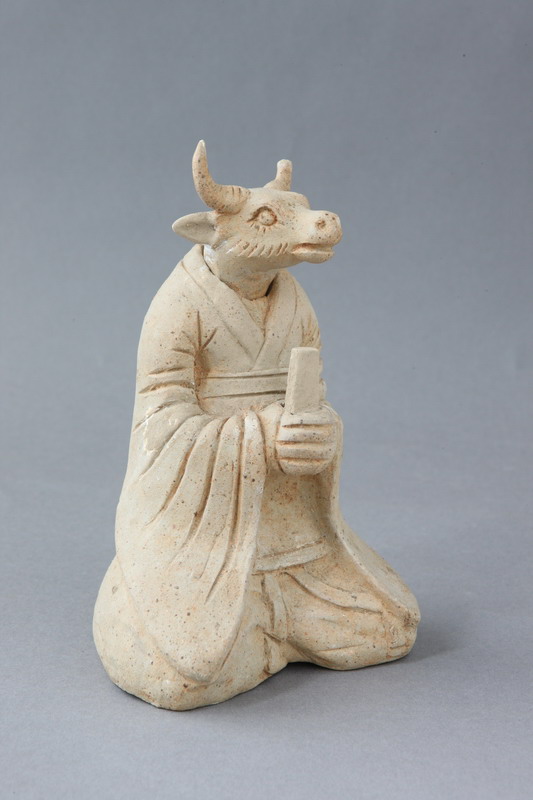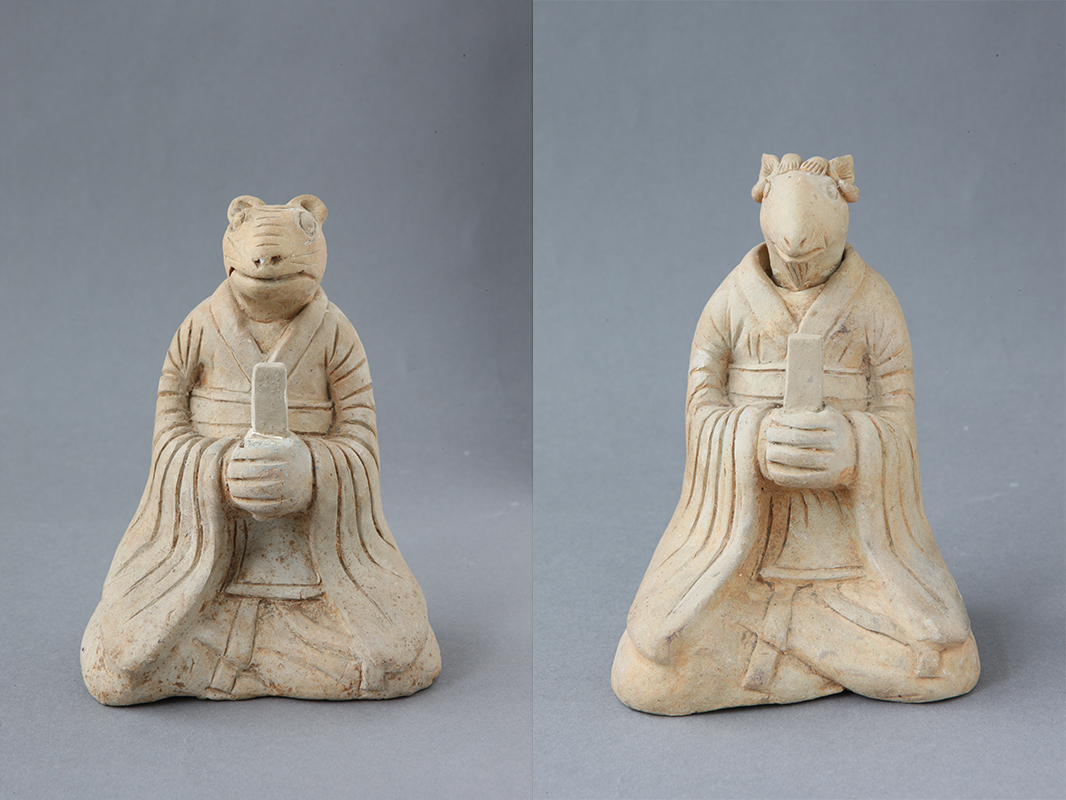Celadon Figurine of the Chinese Zodiac Sign—Ox
Date: Sui Dynasty(AD 581- AD 618)
Overall Height: 17.5cm
Excavated from XiangYin Chengnan Commune

The figurine has an ox's head, wearing a long robe with large sleeves and holding a Hù in both hands. Hù was made of jade, ivory or bamboo, on which ancient ministers could write things down. The head of the ox could be removed from the body, proving that the body and head were made separately. The figurine was found in a niche inside the tomb, along with 11 other Chinese zodiac figurines, which were basically in the same form.
深入探索

Celadon Figurines of the Chinese Zodiac Signs (Rat and Goat)

Celadon figurines of the Chinese Zodiac Signs(Monkey and Rooster)
The 12 Chinese zodiac signs (rat, ox, tiger, rabbit, dragon, snake, horse, goat, monkey, rooster, dog and pig) are matched with the 12 earthly branches(Zǐ,Chǒu,Yín,Mǎo,Chén,Sì,Wǔ,Wèi,Shēn,Yǒu,Xū,Hài) which is the traditional way to chronicle the time in China. Regarding the origin of the Chinese zodiac, it is supposed to be a manifestation of human’s worship to animals. The earliest documentation of the Chinese zodiac signs was found in the tomb No. 11 of Shuidihu(Yunmeng County, Hubei Province)in 1975 and in the tomb No. 1 of Fangmatan(Tianshui ,Gansu Province) in 1986, both of which contained records of the twelve Chinese zodiac signs, indicating that the Chinese zodiac signs had already taken shape during the pre-Qin period. Wang Chong of the Eastern Han Dynasty wrote that the twelve animals are matched with the twelve earthly branches, which are basically the same as the twelve zodiac signs of later generations.
As for the twelve Chinese zodiac figurines that accompanied the burials, the available archaeological data suggests that they were mostly ceramics in texture. The earliest known example is the tomb No.10 of the Northern Wei Cui burials in Linzi, Shandong, where the twelve figurines of the Chinese zodiac signs were excavated, with more realistic images. The placement of the figurines in the tomb was consistent with the position of the twelve Chinese zodiac figurines in the tomb in the sixth year (610) of the Sui Dynasty in Xiangyin, Hunan, which means that those figurines are placed in the corresponding niches with independent animal images. Thus, it is clear that as burial objects, the twelve figurines must have served a specific function – as a tomb warrior - and were therefore placed in specific positions to fulfil their function, in the same way as the tomb animals.

Twelve figurines of the Chinese zodiac signs(Tiger, Horse, Monkey and Snake) excavated from Tomb No.10 of the Cui burials in the Northern Wei dynasty, Linzi, Shandong
During the Sui and Tang Dynasties after the Northern Dynasties, many tombs in Hunan, Hubei, Sichuan and other southern regions have unearthed figurines of the twelve Chinese zodiac signs. In terms of the shape, compared with the Northern Dynasties, the figurines of the Chinese zodiac signs in the Sui and Tang Dynasties evolved into figurines with animal heads and human figures in a sitting position. Judging from the characteristics of the fetal glaze of the twelve Chinse zodiac figurines unearthed in these southern tombs, they should be produced by Yuezhou kilns.
Around the time of the prosperous Tang dynasty, not only in the south but also in northern tombs, figurines of the Chinese zodiac signs appeared in large numbers, which reflected the influence of southern burial customs on the north. However, there was a difference in the form of the twelve zodiac figurines from the north, which were basically animal-headed figures standing on a round pedestal wearing a large robe with a cross collar and wide sleeves, and were probably of northern origin. After the Tang dynasty, in the Five Dynasties and Ten Kingdoms, and even the Song dynasty, a number of tombs also produced twelve figurines of the Chinese zodiac signs, but they have become a declining trend and tended to be more human in appearance. After the Southern Song dynasty, the twelve Chinese zodiac figurines gradually disappeared as funerary objects.

Terracotta Figurines of the Chinese Zodiac Signs from the National Museum of China



